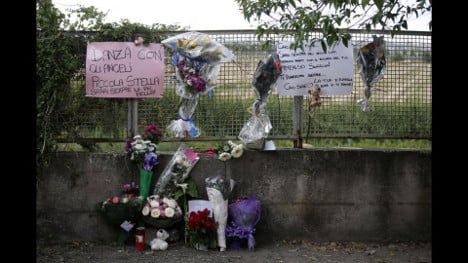Driven by jealousy, Vincenzo Paduano followed her home after a night out, ramming his car into the back of hers before dousing the vehicle with a flammable liquid and setting it alight.
Di Pietrantonio was able to escape from the car, but he chased after her. The student is said to have screamed for help from passing motorists, but nobody stopped.
The 27-year-old security guard then set her alight. Her still-smouldering body was found a few hours later by her mother.
#SaraDiPietrantonio #ciaoSara Quante Sara inascoltate ci sono in #Italia? Leggi tutto e #rt: https://t.co/uJ9osd9J0t pic.twitter.com/IIc2uBtEdS
— ildiretto (@ildiretto) June 8, 2016
Paduano soon confessed to the crime, telling investigators that he couldn't accept that she'd abandoned him.
He also reportedly admitted: “I am really a monster. I am obsessive, paranoid, jealous.”
Di Pietrantonio became the 55th “femicide” victim in Italy so far this year – three more were murdered by either a spouse, boyfriend or ex within a few weeks after.
Last year, 128 women were victims of femicide, the year before there were 136. Thousands more have suffered domestic abuse or are stalked by men.
These figures come from Telefono Rosa, a women's rights organization offering legal advice and counselling.
But they are just the tip of the iceberg: an estimated 90 percent of these crimes go unreported.
In some ways, the situation has improved. Italy's government has taken steps to address violence against women, introducing an ‘anti-femicide’ law and appointing a government advisor on the issue in 2013 – after being shamed into action by a damning UN report, which called domestic abuse “the most pervasive form of violence in Italy”.
But while legislation is an important step, changing the mentality and culture that lie behind the attacks will take much longer. Most femicides and rapes are carried out by partners or – most often – ex-partners, according to figures from Istat released in 2015, which also showed that while the overall number of incidents has declined slightly, acts of violence are becoming more serious, with more women fearing for their lives.
Divorced or separated women are most at risk, with over half suffering violence (compared to 31.5 percent on average), and attacks often occur after the victim has begun a new relationship, as was the case with Di Pietrantonio.
Disturbingly, a 2015 study by non-profit organization We World found that one in four young Italians believed violence against women could be justified by “love”, or exasperation at the woman or her clothing.
So how can the country get to the root of the problem and tackle the perception of violence as a legitimate reaction to rejection?
Centres offering anger management courses and other treatment, aimed directly at men who consider themselves violent, are growing in number across the country.
The president of Ferrara’s Cam (Centre for violent men), Michele Poli, says there is no common factor among the men the centre has worked with.
“Violence against women happens across-the-board,” he told The Local. “It’s about a patriarchal culture which validates violence against women and prevents effective action against it,” he said, adding that every member of society must actively work towards change.
Poli says the centre has been able to measure the success of its courses through interviews with the men’s partners – or sometimes ex-partners – carried out at the start, middle and end of the course.
Another centre includes the following testimony in its advertising material: “Now I know that nothing justifies my violent behaviour”.
Men receive treatment at the centre either after being referred by a doctor or social services worker – which may mean the treatment comes too late – or by self-referral, which relies on men to recognize that they have a problem and take responsibility for dealing with it.
One centre appeals to those who “do not consider themselves to be a violent person” but may have hurt their partners “without meaning to” – but how are men going to seek out this kind of help if they are not properly educated on respect and domestic violence?
Laura Boldrini, an Italian politican and long-time advocate for women's rights, said: “the voice of men is missing” in the discourse and spoke of the need to “change the mentality of men”, arguing that schools in particular must do more to educate young boys. Many men seem unwilling to acknowledge the sexism underlying Italian society; Italian media coverage of attacks on women overwhelmingly focuses on cases where the perpetrator is foreign, despite the fact that in most cases, they are carried out by Italian men.
Monica Pepe and Luca Cardin, who run online magazine Zero Violenza, told The Local that more and more men, including high profile figures, are adding their voices to the discussion. Their organization is working on training teachers and parents on how to ensure that their children are equipped to deal with the opposite gender in a healthy manner.
“No man is born violent, but becomes violent for a variety of reasons linked to their environment, family, society and education,” they said. “At Zeroviolenza, we have created violence prevention training for parents and teachers together, because it is important that they are aware of the importance of their role in the formation of the younger generation.
“The goal of our courses is to deconstruct the most common stereotypes and look at the meaning of identity and belonging to a genre. Respect and recognition of the individual need to come before gender difference.”
Pepe and Cardin also pointed out the lack of sex education and emotional education in the Italian school system, which shows that “bogeyman still represents healthy, responsible sexuality.”
Some schools are introducing lessons on domestic violence into the curriculum, for example in Turin, where boys are educated on consent and girls taught how to spot the signs of abuse. The University of Bologna is the only one in Italy to offer a seminar dedicated to violence against women, which includes discussions with those who have suffered.
But on the whole, the issue is still “taboo”, as three students at the university explained to The Local.
One of them, Irene, said her only experience of domestic violence being discussed in school was a PE lesson in self-defence. “The teacher spoke to us specifically about female self-defence – psychological as well as physical – and how to avoid a violent man. But this doesn’t tackle the problem at its roots,” she says.
Another student, Chiara, 21, said: “Italian schools don’t pay attention to gender-based violence at all, and no one talks about domestic abuse. We don’t even study the story of feminism.” She added that some men disagree with the idea of courses on gender or relationships, because they feel it labels them all as violent.
The reluctance to address the topic means that women are often left to shoulder responsibility for their protection themselves. One mayor celebrated International Women’s Day this year by handing out pepper spray to female residents, while a Milan-based women’s organization recently launched an app named ‘Stalking Buster’ launched, allowing women to keep a record of incidents and contact police immediately.
Sonia, a third student, said that while improvements to the education system were “essential”, it is also crucial to focus on “major means of communication, like TV, advertising and film”. In fact, in the UN report cited above, it commented on the unequal representation of women in Italian media, for example the fact that over half of women shown on TV did not speak, while the rest were overwhelmingly presented in relation to stereotypical topics such as sex and beauty.
Italy’s Rai TV channel has a programme titled ‘Amore Criminale’, running since 2007. Created in collaboration with the Italian police, it does important work in reporting on cases of femicide, as well as speaking to psychologists, criminologists and occasionally formerly violent men who have undergone anger management therapy.
However, the title, which translates as 'Criminal Love', seems to support the idea that the culprits simply 'loved too much'. Accompanying its opening credits are the lyrics “Each man kills the thing he loves”, with the title (which translates as ‘Criminal Love’) encircled in a heart on screen.
And the way the Italian media reports these crimes too often paints them as tragic love stories, illustrating articles with smiling photos of the victim and her killer when they were a couple. One recent headline read ‘He killed his partner with a vase of flowers’ – only explaining later in the article that the relationship had ended over a year earlier.
Reports often refer to the victim as the ‘girlfriend’ or ‘partner’ of her killer, even when the relationship ended some time previously; the woman obviously did not want to be seen as the man’s partner, and the tragedy is not that the 'happy couple' has been torn apart, but that a woman has been killed by a man who saw her as a possession. This kind of reporting unfortunately plays into the narrative of the perpetrators.
Lucia Annibali, the victim of an acid attack by an ex-partner, addressed this issue in her book, called: Here I am: My Story of Non-Love.
Its blurb sums up the problem, saying: “The outline is unfortunately ‘classic’: possession mistaken for love, anger which becomes ferocious, up to the ultimate cruelty.”




 Please whitelist us to continue reading.
Please whitelist us to continue reading.
Member comments